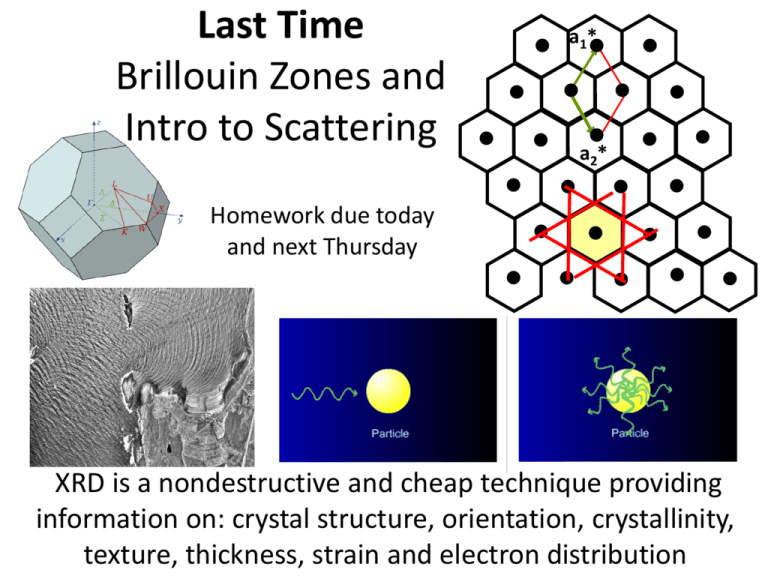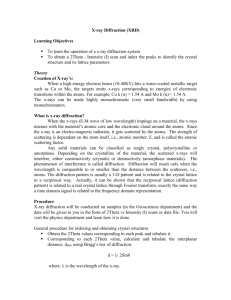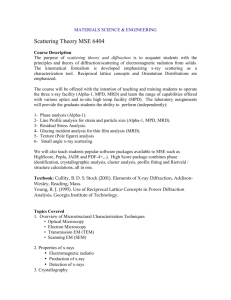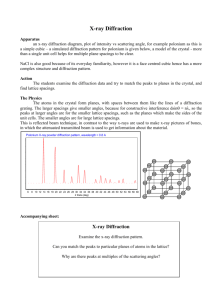Ewald Sphere and Diffraction Techniques
advertisement

Last Time Brillouin Zones and Intro to Scattering a1* a2* Homework due today and next Thursday XRD is a nondestructive and cheap technique providing information on: crystal structure, orientation, crystallinity, texture, thickness, strain and electron distribution Learning Objectives for Diffraction After our diffraction topic you should be able to: • Understand/ apply Bragg’s law • Discuss a few different diffraction techniques and their purposes • (Next time) Calculate the structure factor for simple cubic, bcc, fcc, diamond, rock salt, cesium chloride • Alternative reference: Ch. 2 Kittel Diffraction In a Crystal In A0 e Incoming radiation amplitude: To calculate amplitude of scattered waves at detector position, sum over contributions of all scattering centers Pi with scattering amplitude (form factor) f: Pi ri ko Det In (ri ) f (r i )eik ( Rr ) R i R’ source R, R’ >> ri Det A0 e i ( k 0 R k ' R ) ik 0 ( R ri ) f (r )e R’-ri iri ( k 0 k ') i The intensity that is measured (can’t measure amplitude) is I (K ) f (r )e ir K 2 dr K k 'k 0 Scattering vector The book calls K, but G is another common notation. The Bottom Line I (K ) f (r)e ir K 2 dr K k 'k 0 If you do the math you can prove that the peaks only occur when (a1, a2, a3 = lattice vectors): n1, n2, n3 integers a1 K 2n1 a2 K 2n2 a3 K 2n3 Compare these relations to the properties of reciprocal lattice vectors: K hkl a1 2h K hkl a2 2k K hkl a3 2l The Laue Condition Replacing n1 n2 n3 with the familiar h k l, we see that these three conditions are equivalently expressed as: K hb1 kb2 lb3 K (Max von Laue, 1911) So, the condition for nonzero intensity is that the scattering vector K is a translation vector of the reciprocal lattice. From Laue to Bragg The magnitude of the scattering vector K depends on the angle between the incident wave vector and the scattered wave vector: K k 'k 0 Show vector k o k' subtraction on k' 2 d hkl Elastic scattering requires: 2 ko k ' k So from the wave vector triangle and the Laue condition we see: K the board ko Notice this angle is 2! 2 4 K 2k sin sin d hkl Leaving Bragg’s law: 2d hkl sin If the Bragg condition is not met, the incoming wave just moves through the lattice and emerges on the other side of the crystal (neglecting absorption) How does this limit ? 2d hkl sin n where, d is the spacing of the planes and n is the order of diffraction. • Bragg reflection can only occur for wavelength n 2d • This is why we cannot use visible light. No diffraction occurs when the above condition is not satisfied. Bragg Equation: 2d sin n The diffracted beams (reflections) from any set of lattice planes can only occur at particular angles pradicted by the Bragg law. Bragg-Brentano diffractometer (θin=θout) Above are 1st, 2nd, 3rd and 4th order “reflections” from the (111) face of NaCl. Orders of reflections are given as 111, 222, 333, 444, etc. (without parentheses!) A single crystal specimen in a Bragg-Brentano diffractometer (θin=θout) would produce only one family of peaks in the diffraction pattern. 2 The (110) planes would diffract at At 20.6° (2), 29.3 °2; however, the detector is Bragg’s law fulfilled not at that position (the for the (100) planes, perpendicular to those planes does producing a not bisect the incident and diffraction peak. diffracted beams). Only background is observed. Why might you use this technique? The (200) planes are parallel to the (100) planes. Therefore, they also diffract for this crystal. Since d200 is ½ d100, they appear at 42° (2). THE EWALD SPHERE (Will show a few ways) Consider an arbitrary sphere passing through the reciprocal lattice, with the crystal arranged in the center of the sphere. We specify two conditions: (1) the sphere radius is 2 / - the inverse wavelength of X-ray radiation (2) the origin of the reciprocal lattice lies on the surface of the sphere diffracted ray X-rays are ON 2 2/ The diffraction spot will be observed when a reciprocal lattice point crosses the Ewald sphere O 10 A sphere of radius k Surface intersects a point in reciprocal space and its origin is at the tip of the incident wavevector. Sphere rotated around point (0,0) in reciprocal lattice space. Any points which intersect the surface of the sphere indicate where diffraction peaks will be observed if the structure factor is nonzero (later). The Ewald Sphere Reciprocal Space 2 KD Ki 02 Only a few angles 01 The Ewald Sphere touches the reciprocal lattice (for point 41) 00 DK 10 20 (41) Bragg’s equation is satisfied for 41 1. Longitudinal or θ-2θ scan Sample moves as θ, Detector follows as 2θ k0 k’ 0 10 20 30 40 1. Longitudinal or θ-2θ scan Sample moves on θ, Detector follows on 2θ k0 K k’ 0 10 20 30 Reciprocal lattice rotates by θ during scan 40 1. Longitudinal or θ-2θ scan Sample moves on θ, Detector follows on 2θ k0 K k’ 2 0 10 20 30 40 1. Longitudinal or θ-2θ scan Sample moves on θ, Detector follows on 2θ k0 K k’ 2 0 10 20 30 40 1. Longitudinal or θ-2θ scan Sample moves on θ, Detector follows on 2θ k0 K k’ 2 0 10 20 30 40 1. Longitudinal or θ-2θ scan Sample moves on θ, Detector follows on 2θ k0 K 2k’ 0 10 20 30 40 1. Longitudinal or θ-2θ scan Sample moves on θ, Detector follows on 2θ k0 K k’ 2 0 10 20 •Provides information about relative arrangements, angles, and spacings between crystal planes. 30 40 Higher order diffraction peaks http://www.doitpoms.ac.uk/tlplib/reciprocal_lattice/ewald.php http://www.physics.byu.edu/faculty/campbell/animations/x-ray_diffraction.html 3 COMMON X-RAY DIFFRACTION METHODS X-Ray Diffraction Method Laue Rotating Crystal Powder Orientation Single Crystal Polychromatic Beam Fixed Angle Lattice constant Single Crystal Monochromatic Beam Variable Angle Lattice Parameters Polycrystal/Powder Monochromatic Beam Fixed Angle Back-reflection vs. Transmission Laue Methods In the back-reflection method, the film is placed between the x-ray source and the crystal. The beams which are diffracted backward are recorded. Which is this? X-rays have wide wavelength range (called whiteSingle beam). Crystal X-Ray Film X-Ray Single Crystal Film The diffraction spots generally lay on: a hyperbola an ellipse LAUE METHOD The diffracted beams form arrays of spots, that lie on curves on the film. Each set of planes in the crystal picks out and diffracts a particular wavelength from the white radiation that satisfies the Bragg law for the values of d and θ involved. 22 Laue Pattern The symmetry of the spot pattern reflects the symmetry of the crystal when viewed along the direction of the incident beam. Great for symmetry and orientation determination Crystal structure determination by Laue method? • Although the Laue method can be used, several wavelengths can reflect in different orders from the same set of planes, making structure determination difficult (use when structure known for orientation or strain). • Rotating crystal method overcomes this problem. How? ROTATING CRYSTAL METHOD A single crystal is mounted with a rotation axis perpendicular to a monochromatic x-ray beam. A cylindrical film is placed around it and the crystal is rotated. Sets of lattice planes will at some point make the correct Bragg angle, and at that point a diffracted beam will be formed. Rotating Crystal Method Reflected beams are located on imaginary cones. By recording the diffraction patterns (both angles and intensities), one can determine the shape and size of unit cell as well as arrangement of atoms inside the cell. But around what axis should you rotate? Film THE POWDER METHOD Least crystal information needed ahead of time If a powder is used, instead of a single crystal, then there is no need to rotate the sample, because there will always be some crystals at an orientation for which diffraction is permitted. A monochromatic X-ray beam is incident on a powdered or polycrystalline sample. The Powder Method • A If the asample monochromatic sample of some beam tens is of consists some x-ray hundreds of directed of randomly at aa single orientated crystal, single then crystals (i.e. powdered sample) only one crystals, the or the two diffracted diffracted beams are show that diffracted beams may result. seen to lie oncones. the surface of form continuous several A circle cones. of film is used to record the diffraction The cones may point forwards pattern as both shown. and backwards. Each cone intersects the film giving diffraction arcs. 28 Powder diffraction film When the film is removed from the camera, flattened and processed, it shows the diffraction lines and the holes for the incident and transmitted beams. 29 K Useful for Phase Identification The diffraction pattern for every phase is as unique as your fingerprint – Phases with the same element composition can have drastically different diffraction patterns. – Use the position and relative intensity of a series of peaks to match experimental data to the reference patterns in the database Databases such as the Powder Diffraction File (PDF) contain dI lists for thousands of crystalline phases. • The PDF contains over 200,000 diffraction patterns. • Modern computer programs can help you determine what phases are present in your sample by quickly comparing your diffraction data to all of the patterns in the database. Quantitative Phase Analysis Reference Intensity Ratio Method I(phase a)/I(phase b) .. • With high quality data, you can determine how much of each phase is present • The ratio of peak intensities varies linearly as a function of weight fractions for any two phases in a mixture • RIR method is fast and gives semiquantitative results • Whole pattern fitting/Rietveld refinement is a more accurate but more complicated analysis 60 50 40 30 20 10 0 0 0.2 0.4 0.6 X(phase a)/X(phase b) 0.8 1 Applications of Powder Diffractometry -phase analysis (comparison to known patterns) -unit cell determination (dhkl′s depend on lattice parameters) -particle size estimation (line width) -crystal structure determination (line intensities and profiles) Extra slides • There is a lot of useful information on diffraction. Following are some related slides that I have used or considered using in the past. • A whole course could be taught focusing on diffraction so I can’t cover everything here. XRD: “Rocking” Curve Scan K K ki Sample normal kf “Rock” Sample • Vary ORIENTATION of K relative to sample normal while maintaining its magnitude. How? “Rock” sample over a very small angular range. • Resulting data of Intensity vs. Omega (w, sample angle) shows detailed structure of diffraction peak being investigated. Can inform about quality of sample. Intensity (Counts/s) XRD: Rocking Curve Example GaN Thin Film (002) Reflection 16000 8000 How do you know if this is good? Compare to literature to see how good (some materials naturally easier than others) Generally limited by quality of substrate 0 16.995 17.195 17.395 17.595 17.795 Omega (deg) • Rocking curve of single crystal GaN around (002) diffraction peak showing its detailed structure. X-ray reflectivity (XRR) measurement A glancing, but varying, incident angle, combined with a matching detector angle collects the X rays reflected from the samples surface Calculation of the density, composition, thickness and interface roughness for each particular layer r 10 6 10 5 10 4 10 3 10 2 10 1 10 0 Mo Intensity (a.u.) Edge of TER 0.68 t [Å] s [Å] 19.6 5.8 Kiessig oscillations (fringes) Mo W 1.09 1.00 Si 1.00 Mo 0,5 1,0 1,5 2,0 2,5 3,0 3,5 4,0 4,5 5,0 0.93 236.5 34.0 14.1 5.0 2.7 2.7 2.8 o Diffraction angle ( 2) The surface must be smooth (mirror-like) XRD: Reciprocal-Space Map AlN GaN(002) w w/2 • Vary Orientation and Magnitude of Dk. • Diffraction-Space map of GaN film on AlN buffer shows peaks of each film. The X-ray Shutter is the most important safety device on a diffractometer • X-rays exit the tube through X-ray transparent Be windows. H2O In H2O Out XRAYS Be window • X-Ray safety shutters contain the beam so that you may work in the diffractometer without being exposed to the X-rays. Cu ANODE Be window Primary Shutter eXRAYS Secondary Shutter FILAMENT (cathode) Solenoid metal glass (vacuum) • Being aware of the status of the shutters is the most important factor in working safely with X rays. (vacuum) AC CURRENT SAFETY SHUTTERS Non-xray Diffraction Methods (more in later chapters) • Any particle will scatter and create diffraction pattern • Beams are selected by experimentalists depending on sensitivity – X-rays not sensitive to low Z elements, but neutrons are – Electrons sensitive to surface structure if energy is low – Atoms (e.g., helium) sensitive to surface only • For inelastic scattering, momentum conservation is important Electron X-Ray Neutron λ = 1A° λ = 1A° λ = 2A° E ~ 104 eV E ~ 0.08 eV E ~ 150 eV interact with electron Penetrating interact with nuclei Highly Penetrating interact with electron Less Penetrating Group: Consider Neutron Diffraction • Qualitatively discuss the atomic scattering factor (e.g., as a function of scattering angle) for neutron diffraction (compared to x-ray) by a crystalline solid. • For x-rays, we saw that f is related to Z and has a strong angular component. For neutrons? • The same equation applies, but since the neutron scatters off a tiny nucleus, scattering is more point-like, and f is ~ independent of . Preferred Orientation (texture) Diffracting crystallites • Preferred orientation of crystallites can create a systematic variation in diffraction peak intensities – can qualitatively analyze using a 1D diffraction pattern – a pole figure maps the intensity of a single peak as a function of tilt and rotation of the sample • this can be used to quantify the texture 10.0 00-004-0784> Gold - Au (111) Intensity(Counts) 8.0 (311) (200) 6.0 (220) 4.0 (222) 2.0 (400) x10 3 40 50 60 70 Two-Theta (deg) 80 90 100





